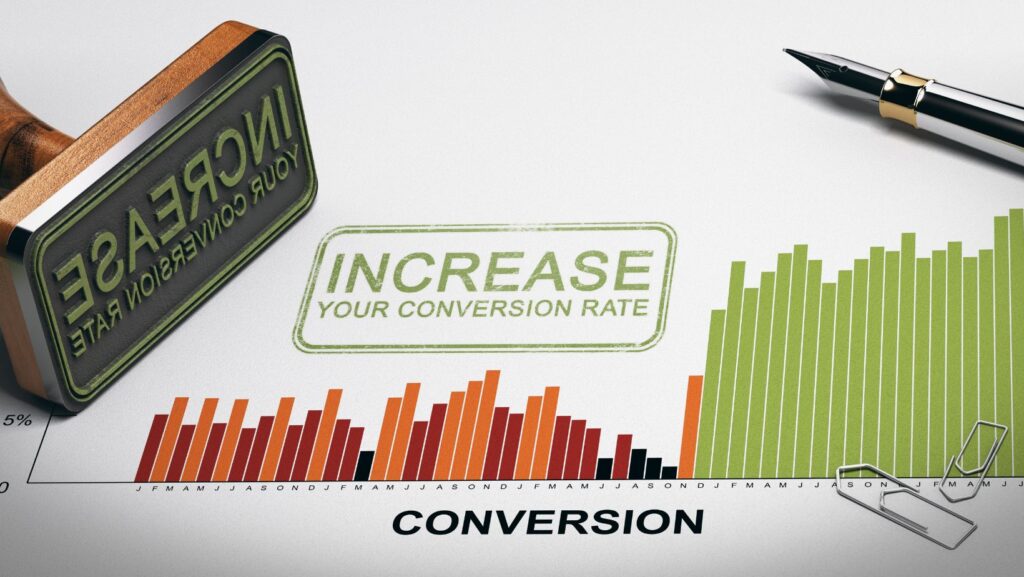Conversion Rate Optimization (CRO) Essentials: Amplify Your Website’s Impact

Your website is more than just an online store. It’s a point at which potential customers decide whether or not to engage with your brand. Conversion Rate Optimization (CRO) comes into play here.
The systematic practice of raising the percentage of website visitors who complete a desired action, such as filling out a form or becoming clients, is known as conversion rate optimization (CRO).
Significance of conversion rate optimization (CRO) in digital marketing cannot be emphasized. It’s the formula for converting inactive website visitors into active users and consumers.
Let us dig into the area of CRO in this post, researching ways that might dramatically improve the performance of your website.
Understanding Conversion Rate Optimization
CRO is analogous to bringing visitors into your home. You want them to feel at ease, to find everything they need quickly, and to have a great experience.
It entails comprehending how people traverse your site, what activities they do during their visit, and what prevents them from performing your desired behaviors.
Bounce rate, exit rate, average session time, and, of course, conversion rate are all important indicators in CRO.
These metrics provide useful information about user behavior and the efficiency of your website in generating conversions.
Strategies for Improving CRO

Website Design
The design of your website is the digital equivalent of a firm handshake or a welcoming smile. It’s the first impression that can make or break your relationship with potential customers.
A well-designed website is like a well-organized store where visitors can easily find what they’re looking for, and they’re more likely to stick around.
Prioritize a clean, visually appealing design that aligns with your brand identity.
Ensure that your website is not just desktop-friendly, but also mobile-optimized.
Approximately 60% of global web traffic coming from mobile devices in 2020, according to Statista, mobile optimization is no longer optional, but a necessity.
User Experience (UX)
Speed is king. According to a Google study, the probability of bounce increases by 32% as page load time grows from one to three seconds.
That’s a third of your potential customers lost even before they’ve had a chance to see what you offer! To prevent this, ensure your website loads quickly, ideally in under two seconds.
Navigation should be a breeze, with a well-structured menu and a search function for easy access to information.
Your content should be more than just clear and concise. And the content should be engaging, valuable, and tailored to your audience’s needs and interests.
Crafting Compelling Call-to-Action (CTA)
Your CTA is the beacon that guides your visitors towards conversion. It’s the difference between a visitor and a customer.
A compelling CTA is like a persuasive salesperson. It convinces visitors to take the next step, of making a purchase, signing up for a newsletter, or downloading a resource.
Make your CTAs impossible to ignore by using action-oriented language, contrasting colors, and strategic placement.
Your CTA is not just a button or a link, but culmination of the user’s journey on your website.
Power of A/B Testing
A/B testing is the scientific method of the digital marketing world. It allows you to pit two versions of a webpage against each other to determine which one drives more conversions.
It’s like conducting a taste test. You present two options and see which one your audience prefers.
You could test two different headlines, images, or CTA buttons. The key is to change only one element at a time so you can pinpoint exactly what caused the difference in results.
Leveraging Analytics for Data-Driven Decisions
In the realm of CRO, data is your compass. It points you in the right direction and helps you navigate the vast landscape of user behavior.
Tools like Google Analytics serve as your GPS, providing you with detailed data on your users’ behavior, such as which pages they visit, how long they stay, and what path they take towards conversion.
This data is more than just numbers. It can be a goldmine of insights that can inform your CRO strategies and help you make decisions that are rooted in reality, not assumptions.
Personalizing User Experience
In the age of digital marketing, personalization is the key to standing out from the crowd. It’s like a tailor-made suit.
It fits perfectly and makes the wearer feel special. Use data to understand your users’ preferences and behaviors, and tailor your content, offers, and overall website experience to meet their needs.
Personalized experiences can significantly boost user engagement and conversion rates.
An Epsilon survey, 80% of consumers are more likely to purchase when brands provide individualized experiences.
Building Trust with Social Proof
Social proof is the digital equivalent of word-of-mouth marketing. It’s the online reviews, testimonials, and case studies that show your visitors that other people trust and value your brand.
It’s like a friend’s recommendation, and it carries weight and can significantly influence decision-making. Incorporate social proof into your website to build trust and credibility.
According to a Spiegel Research Center research, showing reviews can boost conversion rates by up to 270%.
Optimizing for SEO
SEO may seem like a different ball game, but it plays a crucial role in CRO. What’s the use of a well-optimized website if it’s not visible to your target audience? SEO is like a roadmap that leads potential customers to your website.
Use relevant keywords, optimize your meta tags, and create high-quality content to improve your search engine rankings and drive organic traffic to your website.
Offering Exceptional Customer Service
Exceptional customer service can be a significant change in improving your conversion rate. It’s like a helpful store assistant – it enhances the shopping experience and leaves a positive impression.
Provide live chat support, offer help guides, and ensure your contact information is easily accessible.
According to a Microsoft study, 96% of consumers feel customer service is a significant component in their brand loyalty decision.
Creating a Sense of Urgency
Creating a sense of urgency is a time-tested strategy that can significantly boost your conversion rate. It’s like a ticking clock and it compels users to act quickly or risk missing out. Use limited time offers, countdown timers, and stock level indicators to create a sense of scarcity and prompt users to take immediate action.
Case Studies

Amazon: Amazon is a perfect example of a corporation that has successfully implemented CRO tactics. They are continually testing and optimizing their website, making little adjustments, and measuring the effect on conversion rates. They’ve incorporated a feature called “Customers who bought this also bought…” that gives users personalized suggestions based on their browsing and purchasing history. This method has improved their cross-selling and upselling opportunities dramatically, resulting in higher conversion rates.
Booking.com: Booking.com has also made excellent use of CRO strategies. They use scarcity tactics to encourage users to make a booking. When you search for a hotel on their website, you’ll often see messages like “In high demand with only 3 rooms left!” or “16 other people are looking at this property”. These messages create a sense of urgency, prompting users to book quickly to avoid missing out. This strategy has been amazingly effective in increasing their conversion rates.
Netflix: Netflix makes heavy use of A/B testing to optimize their website and increase conversion rates. Everything from the visuals and trailers used for their broadcasts to the layout of their webpage is tested. They are able to create a tailored and engaging user experience by continuously testing, adjusting, and improving, which has contributed to their strong conversion rates.
Common Mistakes in CRO and How to Avoid Them

Getting started with Conversion Rate Optimization (CRO) might feel like navigating a minefield, with potential pitfalls at every turn.
Identifying these frequent blunders, you can proactively avoid them and keep your CRO strategy on track.
The first typical error is to begin sail without a definite destination – that is, without clear, measurable aims.
This is analogous to walking aimlessly through a wilderness without a map. Resolve this by defining what conversion means for your website and setting clear, quantifiable conversion targets.
Another common blunder is disregarding your audience’s mobile portion.
With mobile devices now accounting for the bulk of web traffic, a non-mobile-friendly website can dramatically reduce conversion rates.
Make sure your website is responsive and provides consistent experience across all devices.
Making improvements on the basis of assumptions rather than data is analogous to shooting arrows in the dark.
Make informed judgments using analytics and user behavior data and use A/B testing to support your theories.
Data is your guiding star in the world of CRO, and it helps you avoid the “one and done” approach. CRO is a continual process that necessitates constant testing and optimization.
Action List

Define Clear, Measurable Goals
- Identify what a successful conversion looks like for your website.
- Set specific, measurable goals related to these conversions.
- Regularly review and adjust your goals as needed.
Improve Website Design
- Evaluate your current website design and identify areas for improvement.
- Implement a clean, aesthetically pleasing design that aligns with your brand identity.
- Ensure your website is user-friendly with intuitive navigation.
Optimize for Mobile
- Test your website on various devices to ensure it’s responsive.
- Make necessary adjustments to provide a seamless experience on all devices.
- Regularly update your website to keep up with changes in mobile technology.
Enhance User Experience (UX)
- Check your website speed and optimize it for faster loading times.
- Ensure your website navigation is easy and intuitive.
- Create and share valuable content that meets your users’ needs and expectations.
Craft Compelling Call-to-Action (CTA)
- Review your current CTAs and assess their effectiveness.
- Make your CTAs clear, compelling, and strategically placed.
- Test different CTAs to see which ones drive more conversions.
Utilize A/B Testing
- Identify elements of your webpages to test (e.g., headlines, images, CTAs).
- Conduct A/B tests to compare different versions of these elements.
- Analyze the results and implement a more successful version.
Leverage Analytics
- Set up tools like Google Analytics to track user behavior on your website.
- Regularly review and analyze this data to gain insights into your users’ behavior.
- Use these insights to make data-driven decisions and improve your CRO strategies.
Personalize User Experience
- Use data to understand your users’ preferences and behaviors.
- Tailor your content, offers, and overall website experience to meet these needs.
- Regularly update your personalization strategies based on user feedback and data.
Build Trust with Social Proof
- Collect and display reviews and testimonials from your customers.
- Share case studies to highlight the effectiveness of your product or service.
- Regularly update your social proof to keep it relevant and compelling.
Optimize for SEO
- Determine relevant keywords for your company and use them into the text of your website.
- Optimize your meta tags for improved search engine visibility.
- Regularly create and share high-quality content to boost your search engine rankings.
Offer Exceptional Customer Service
- Set up live chat support to assist your users in real-time.
- Create and share help guides to answer common user questions.
- Ensure your contact information is easily accessible for users who need further assistance.
Create a Sense of Urgency
- Implement limited time offers to encourage users to act quickly.
- Use countdown timers and stock level indicators to create a sense of scarcity.
- Regularly update your offers to keep them fresh and exciting.
Final Thoughts
CRO is a highly effective weapon in your digital marketing arsenal. You may increase your website’s conversion rate by optimizing its design, increasing user experience, creating effective CTAs, using A/B testing, and leveraging analytics.
The goal is to convert that traffic into active users and customers, not just increase traffic to your website.
It is now time to put these plans into effect. Begin by examining your website and finding potential improvements. Try out several techniques to find which ones work best for your target demographic.
CRO is a never-ending cycle of testing, learning, and optimizing.
Don’t be scared to try new things or to think beyond the box. And, if you need assistance, don’t be afraid to contact a CRO professional.
Your website is an important asset and improving it for conversions can dramatically improve the performance of your company.
Not only is visibility at stake, but so is genuine engagement that leads to conversion. As you begin your CRO journey, keep in mind that every aspect of your website, from design to content, plays a role in this process.
You can turn your website into a powerful conversion engine by understanding your users, utilizing data, and continuously tweaking your strategy. Happy Optimization!
FAQ
Q: What is Conversion Rate Optimization (CRO)?
A: Conversion Rate Optimization (CRO) is a methodical process of raising the percentage of website visitors who perform a desired activity on a webpage, such as filling out a form, becoming customers, or doing something else.
Q: Why is CRO important for my website?
A: CRO is critical since it allows you to minimize your customer acquisition costs by maximizing the value of your existing visits and users. You can boost income per visitor, acquire more customers, and grow your business by optimizing your conversion rate.
Q: What are some effective strategies for improving CRO?
A: Improving website design, enhancing user experience, crafting compelling CTAs, utilizing A/B testing, leveraging analytics, personalizing user experience, building trust with social proof, optimizing for SEO, providing exceptional customer service, and creating a sense of urgency are some effective strategies.
Q: What is A/B testing and why is it important in CRO?
A: A/B testing compares two versions of a website to evaluate which performs better. It’s a great tool for comparing modifications to your website to the current design and determining which one provides better results. This can assist you in making data-driven decisions and increasing conversion rates.
Q: What are some common mistakes in CRO and how can I avoid them?
A: Setting clear, quantifiable goals, ignoring mobile optimization, making changes based on assumptions rather than data, ignoring user experience, and failing to implement A/B testing are all common blunders. Setting clear goals, optimizing your website for mobile, making data-driven decisions, emphasizing user experience, and doing A/B tests on a regular basis might help you avoid these blunders.
Bio

Ronnie Patterson
Ronnie Patterson, founder of MagnÜron, is a multifaceted entrepreneur with a diverse background in music, electronics engineering, and engineering management. Drawing on experience across various industries, He offers expertise in SEO, operations, and strategy to help businesses thrive. Possessing a unique perspective and unwavering commitment to collaboration, and ideal partner for growth and success.






